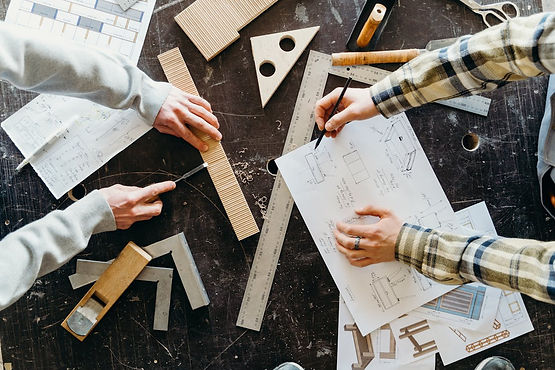Structural design is one of the fundamental pillars of civil engineering and building construction, as it ensures the safety, stability, and functionality of structures. Through meticulous analysis and the application of physical and mathematical principles, structural engineers design the foundations and frameworks that support a building, withstanding external loads such as wind, the weight of occupants, and seismic movements.
The primary function of structural design is to ensure that buildings are safe and efficient, preventing failures that could endanger occupants and infrastructure. This process begins from the project’s conceptualization to its execution, ensuring that each structural component complies with current regulations and can withstand the various forces it will face.
What is Structural Design?
Structural design is a discipline within civil engineering responsible for creating a structural system that enables a building to safely withstand all external loads and forces it will encounter. This process involves detailed analysis and planning of structural elements, such as beams, columns, and foundations, to ensure they can bear the building’s own weight, as well as additional loads like wind, earthquakes, and everyday use of the structure.
Role of Structural Design in Safety
Structural design ensures that a building is not only functional but also resilient and safe against various external forces. For example, in earthquake-prone areas, structural engineers must design buildings with materials and configurations that can absorb and dissipate seismic energy. Similarly, in regions with strong winds, such as coastal areas, it is crucial for structures to withstand horizontal loads without compromising stability.
Importance of Structural Design in Building Projects
Structural design is an essential component of any modern building project, as it ensures that structures are safe, efficient, and durable. In today’s construction context, where projects are increasingly complex and demanding, having an adequate structural design is crucial to ensure that buildings can withstand the loads and forces they will encounter throughout their lifespan.
Safety and Efficiency
Good structural design directly contributes to building safety, preventing collapses or damage that could endanger occupants. Additionally, it optimizes the use of materials like concrete, steel, or wood by precisely selecting and calculating the necessary quantity and quality for each component. This not only enhances the structure's efficiency but also reduces costs by avoiding material waste or excessive use of resources.
Durability and Adaptability
Another key aspect is the durability of buildings. A well-planned structural design ensures that structures withstand the test of time and natural wear, maintaining their integrity for decades. It also facilitates future modifications or expansions, as a flexible design allows for adapting the structure without compromising its stability or functionality.
Site Assessment
The first phase of structural design involves assessing the site where the project will take place. This includes a detailed analysis of geotechnical conditions (soil type, load-bearing capacity, presence of groundwater) and topographical features (slopes, elevations) of the land. This study is essential for determining the most suitable type of foundation and ensuring the structure has adequate support from its base.
Modeling and Simulation
Once the site is understood, structural engineers turn to advanced structural modeling and simulation tools. These tools allow them to virtually recreate the behavior of the structure under different load conditions, such as wind, earthquakes, and the building’s own weight. This simulation is crucial for predicting how the structure will respond and making adjustments before moving to the construction phase.
Detailed Analysis
In this phase, a detailed analysis of the loads and forces that will affect the building is carried out. Engineers calculate the dead loads (the structure’s own weight), live loads (people, furniture), and environmental loads (wind, earthquakes). Based on these calculations, structural elements such as beams, columns, and foundations are sized to ensure the building’s stability and strength.
Final Documentation
Finally, the final documentation is prepared, including structural plans, technical specifications, and documents detailing all aspects of the design. These plans are essential for construction teams to follow the project according to established standards, ensuring correct execution and the safety of the work.
Key Elements in Building Structural Design
The structural design of buildings involves considering several fundamental components that ensure the stability, safety, and efficiency of the construction. Below are the key elements that structural engineers must take into account.
Structuring: Beams, Columns, and Slabs
Structuring is the first step in designing a building, where elements such as beams, columns, and slabs are designed. These components support the main loads of the building and distribute the weight evenly throughout the structure. Beams typically transfer loads to columns, while slabs support floor weight and distribute it effectively.
Materials: Proper Selection
Material selection is another crucial aspect of structural design. Depending on the type of project, materials such as concrete, steel, wood, or a combination may be chosen. Each material has unique properties, like compression and tensile strength, which make it more suitable for certain parts of the structure. For example, concrete is ideal for resisting compressive loads, while steel has excellent tensile strength.
Structuring: Beams, Columns and Slabs
Structuring is the first fundamental step in the design of a building. At this stage, the main structural elements are defined and designed: beams, columns, and slabs. These components work together to support the building's main loads and ensure uniform weight distribution throughout the structure.
-
Beams: Horizontal elements that transfer the loads from the slabs to the columns.
-
Slabs: They are responsible for supporting the weight of the floors, distributing it efficiently to the beams and columns. Among the slabs, the ribbed slab stands out, which combines joists and vaults to optimize the use of materials and improve structural efficiency.
-
Columns: Vertical elements that receive the loads transferred by the beams and carry them to the foundations.
The use of systems such as joists and vaults in ribbed slabs not only increases structural strength but also reduces the self-weight of the structure, resulting in a more efficient and economical construction.
Normative Requirements and Regulations for Structural Design
Adhering to building codes and local regulations is essential in any structural design project, as these standards are designed to ensure the safety, stability, and durability of buildings. At ME-GA Proyectos de Sonora, we understand the importance of following the strictest standards to protect occupants and ensure long-term safety of constructions. Our solutions align with current regulations in Mexico, including those governing structural design in seismic and risk-prone areas.
In addition to ensuring regulatory compliance, at ME-GA Proyectos de Sonora, we integrate specific considerations such as wind actions and seismic forces, which are essential for the stability of buildings in vulnerable zones. This approach not only ensures that each structure meets legal requirements but also optimizes its performance throughout its lifespan.
Types of Structural Design
In building construction, there are various types of structural design applied according to the specific requirements of each project. Each type has its own benefits and limitations, making it essential to choose the most suitable one based on the building’s characteristics and objectives. Below are the main types of structural design.
Reinforced Concrete Design
Reinforced concrete is one of the most widely used materials in modern construction due to its high compressive strength. This type of design combines concrete with steel bars, which provide tensile strength. It is ideal for structures such as bridges, high-rise buildings, and projects requiring high durability.
Benefits: High durability and compressive strength, suitable for large-scale projects.
Limitations: Heavy weight and extended construction times.
Application: Used in skyscrapers, bridges, and heavy infrastructure buildings.
Structural Steel Design
Laminated steel is known for its strength and flexibility, making it an excellent material for withstanding seismic and wind loads. This type of design is common in commercial and industrial structures due to its ability to bear high tension without breaking.
Benefits: High tensile strength, seismic flexibility, ease of assembly.
Limitations: High cost and susceptibility to corrosion without proper maintenance.
Application: Used in industrial buildings, skyscrapers, and large commercial structures.
Over 30 Years of Experience
With over 30 years of experience, at ME-GA Proyectos we not only comply with local regulations but also employ advanced technologies to exceed expectations in terms of structural safety and durability. This extensive experience allows us to offer solutions that not only meet regulations but also optimize resource use and ensure long-term sustainability.
We specialize in the structural design of buildings that combine concrete and steel structures to guarantee safety, durability and efficiency. An emblematic example is the design of the Fernando Valenzuela Stadium, where we were able to integrate an innovative metallic structure that met high safety and aesthetic standards.
Contact information:
-
Address: Av. 4, 165, Prados del Sol, Hermosillo, Sonora, Mexico.
-
WhatsApp: Write to us at +52 55 7423 3635
-
Phone: Dial us at +52 662 937 0837
-
LinkedIn: Follow our LinkedIn page to learn more about our projects and news.
Visit our services page for more information on how we can help ensure the success of your construction. We’re here to bring your ideas to life!
Preguntas Frecuentes
Our Portfolio
Featured Projects
Discover some of the most iconic projects we have collaborated on, demonstrating our ability to face challenges and exceed expectations.























.png)








.png)